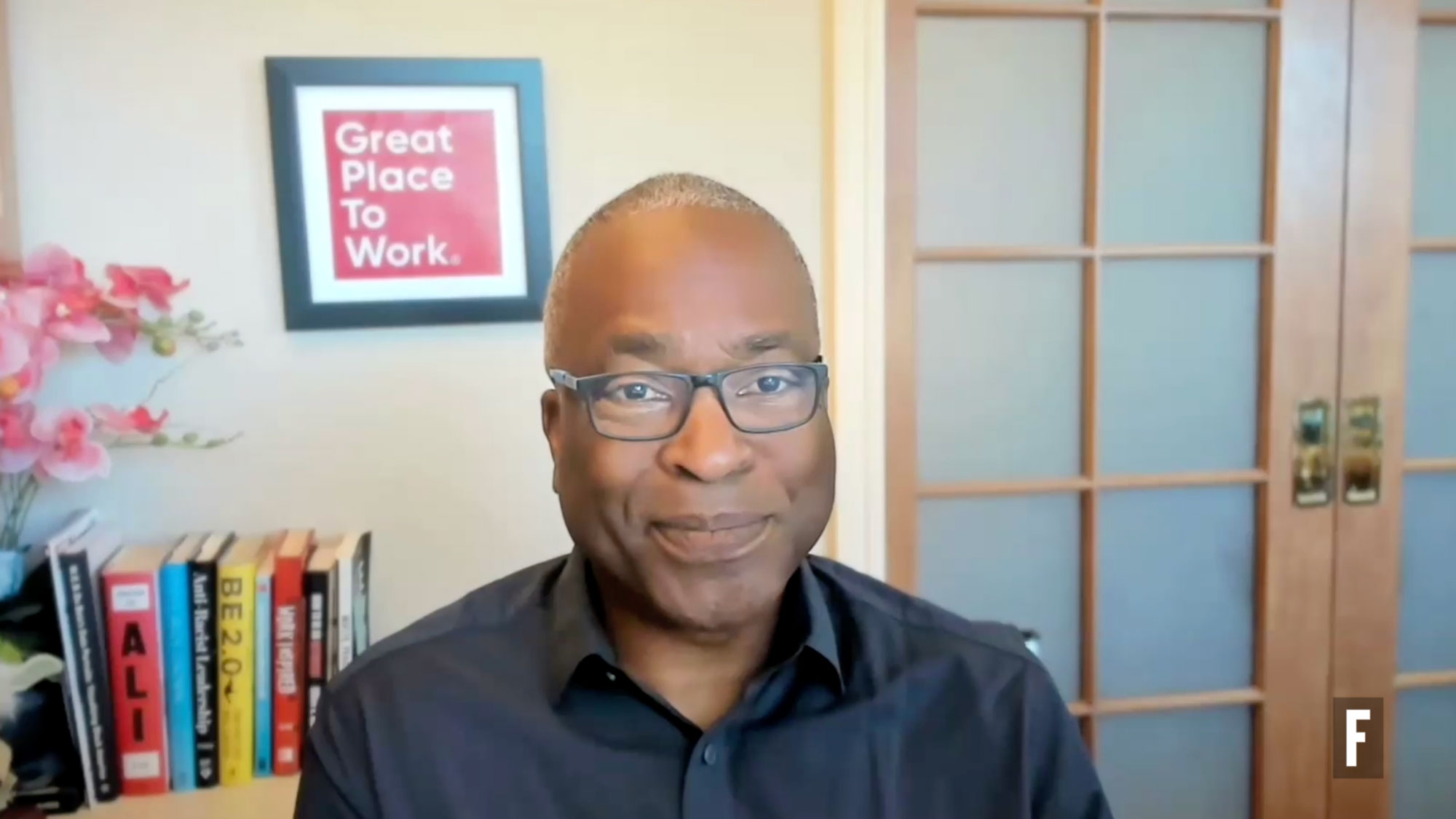ERGs, High-trust leadership, Innovation, Purpose
High-trust workplaces will be the most successful at meeting ESG goals. Here’s how you can engage your workforce.
Sustainability has become a global business imperative.
Nine in 10 (90%) global institutional investors revise their investments when companies do not at least consider ESG criteria, per a recent survey from EY. In a volatile world, business leaders see the need to invest in green energy to future-proof their organizations.
And customers demand more sustainability, too. A recent Deloitte study found that 67% of participants would pay as much as 41% more for a product that was sustainable. The trend was particularly strong with young consumers.
Sustainability is the future of business. To be successful, you are going to need your whole workforce to be engaged and energized to solve problems and find solutions.
A new generation of leaders
To reach climate and sustainability targets, leaders must change.
“We’ve always thought about how do we reach these Sustainable Development Goals, but rarely do we talk about the people and the leadership that it requires to reach those goals,” says Tony Bond, chief diversity and innovation officer at Great Place To Work®.
“A leader creates an environment where people can flourish — but there’s also a correlation with great leadership and the ability to lead sustainable development initiatives.”
Attend our annual company culture conference May 7-9, 2024
At the heart of the issue is trust, the core of what Great Place To Work measures via its proprietary survey. If there isn’t trust between employees and leaders, people won’t come forward to address the risks companies face around non-sustainable business practices.
“Who is in the best position to alert leadership of the risk involved in some of the business practices or products that are being made?” Bond asks. “It’s the employee.”
“If we’re not creating a great place to work, how likely is that person to share this information?”
To meet sustainability goals, organizations need leaders who can build trust.
“About 3.4 billion people in the world work somewhere. Wouldn’t it make sense if we started there and if we created this great environment for people where they work?” - Tondy Bond, chief diversity and innovation officer, Great Place To Work
Quickly making change
Companies who can quickly adapt will be in the best position to win amid an energy transition and threats posed by climate change. Our research shows that high-trust workplaces will be much faster than their competition.
At Great Place To Work Certified™ companies, 82% of employees say people in their organization quickly adapt to change. At the typical U.S. workplace, only 61% said the same.
Some of the biggest drivers of agility come down to an employee’s experience with leaders. When employees say their leaders inspire people to give extra effort, they are 58% more likely to be agile. When leaders have a clear vision for the company, employees are 37% more likely to be agile and 33% more likely when they say managers competently assign tasks and resources.
Clarity unlocks purpose
Effective leadership also ensures that purposeful work drives business success.
In a study with Harvard Business School, Great Place To Work data showed that embracing purpose only led to stronger business performance when employees had clear direction from their leaders. When employees reported meaningful work, and leadership that makes its expectations clear, the companies saw stock market returns that were 6.9% higher than the market.
“This last finding underscores the absolute importance of fostering an effective middle manager layer within firms,” wrote the study’s authors. “Managers who buy into the vision of the company and can make daily decisions that guide the firm in the right direction.”
Great workplaces have leaders who can both set a vision and ensure that middle management throughout the organization can carry their message and empower employees.
At Crowe, setting goals included signing the United Nations Global Compact, which outlines targets to help fight for human rights, the environment, and social good around the world. At Scripps Health, a sustainability webpage was published with articles on how to reduce carbon emissions and reports on company sustainability initiatives.
Publishing a sustainability report is often a crucial step for getting everyone in alignment around ESG goals. “It’s served as a really great organizing framework,” Scott Beckman, director of sustainability for PCL Construction told us last year. “It’s caused a lot of internal discussion when we produce it, from the top levels all the way down.”
At Certified companies, 81% of employees said management has a clear vision for the future of the company, compared to just 59% at typical U.S. companies.
Employee resource groups offer innovation
One tool our research has found to be effective for engaging employees on sustainability? Employee resource groups (ERGs).
Members of ERGs are usually highly engaged employees committed to improving the organization and helping to solve business challenges. Our research has found that ERG members at great workplaces are also 30% more likely to have confidence in their executive team than non-members, a key indicator of future success on sustainability goals.
ERG members can also be crucial voices, ensuring that organizations hear from underrepresented demographics when considering their policies. According to the Environmental Protection Agency, crises created by rising global temperatures and environmental hazards will hit socially vulnerable groups the hardest.
Companies that can tap into their ERGs will be able to get valuable insight and context for their sustainability practices, ensuring that their efforts have the desired impact for communities facing the worst consequences of climate change.
At Scripps Health, an employee-led sustainability council focuses on improving operations across areas including construction, energy, food, grounds, recycling, supply chain, transportation, and vendor partnerships. Panda Restaurant Group coordinates with its Panda Green Committee ERG to run a drive that recycled 500 pounds of electronic waste in 2022.
Making the commute green
Is offering remote work a way to make your workplace more energy efficient?
A new survey from Bospar found that two-thirds of Americans who work from home say they have taken proactive measures to reduce their carbon footprint. Of those who commute to an office, 66% drive a car, while only 7% take public transit.
“Who is in the best position to alert leadership of the risk involved in some of the business practices or products that are being made? It’s the employee.”
More than three-fourths (77%) of respondents to the same survey said that working from home is better for the planet and 58% of Gen Z and 52% of millennials said that celebrating Earth Day while requiring employees to commute was hypocritical. Reasons for this belief came down to increased carbon emissions from transportation and office buildings (63%) and increased use of hazardous materials in workplace settings (58%).
Great workplaces take this into account. Power Home Remodeling, which has a hybrid work model in which most of its employees commute a few days a week, offers employees $3,500 towards the purchase of a new fully electric vehicle.
Tips for leaders
Want to drive sustainability throughout your organization? Here’s what our data says you can focus on:
1. Focus on clarity.
Make sure your sustainability goals are intrinsically tied to business outcomes and company values. Ask: Where can our organization have the greatest impact? Companies that have clear and effective leadership are seeing that a commitment to purpose drives higher business performance.
2. Involve every employee in sustainability.
ERGs can be helpful partners, providing highly engaged and diverse employee populations to tackle issues across the organization. Can your ERGs do a SWOT analysis of your current sustainability practices or attend leadership meetings on sustainability? Consider making sustainability metrics a KPI for ERG groups.
3. Invest in trust.
By becoming a great workplace, your organization can have a profound impact on employees and the communities where they live and work. If every company in the world offered a high-trust culture, the world could make significant strides toward the 17 Sustainable Development Goals outlined by the United Nations.
“If we’re taking care of people’s well-being in the workplace, that’s a big part of this whole initiative, gender equality, decent work,” Bond says. “About 3.4 billion people in the world work somewhere. Wouldn’t it make sense if we started there and if we created this great environment for people where they work?”
When everyone has a great workplace, the benefits will be felt in many different ways. “Our impact on the external environment, socially and environmentally, can be even greater,” Bond says.
Get more insights
Learn more strategies from our workplace culture experts at our For All™ Summit, May 7-9 in New Orleans.












